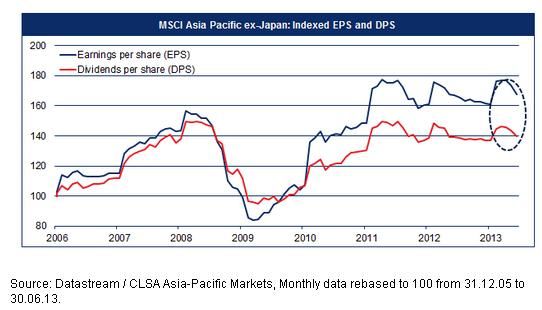May and June were pretty brutal for Asian equity markets. The US Federal Reserve’s announcement about a gradual withdrawal of quantitative easing combined with a significant move higher in US 10-year treasury yields prompted investors to rethink allocations based on low growth, low interest rates and high liquidity. Many defensive sectors proved to be anything but defensive and fully participated in the downturn. Is this the first indication that the yield trade has run its course?
Clearly the move higher in US treasury yields is a negative for longer duration yielding assets. This ‘carry trade’, which has compressed yields across the world and in many different asset classes, becomes less compelling under this scenario. But it is important to remember that core government bond yields still sit at very low levels compared to historical averages. The recent volatility was inevitable considering the overvaluation of bonds in particular and even some equities. It was inconceivable that long-term interest rates would stay low indefinitely, and with more and more ‘hot’ money chasing the same trade, it is easy to see why a slight change of outlook could produce such violent reactions.
The sell-off in US treasuries was understandable but the case was less clear for equities. Although the valuations of equities are impacted by expectations of long-term interest rates, the attraction for most income seekers is the comparison of dividend yield with the rates available for cash on deposit. The comments made recently by Ben Bernanke suggest that short-term interest rates are likely to remain low for some time and as a result the appeal of dividend yield over cash is still very much in place.
Asia also offers some distinct advantages over other equity income strategies. With the yield from some traditional sources compressed to unattractive levels, we believe that dividend growth will become an increasingly important driver for income strategies. From a cyclical perspective, the underlying economic growth is expected to remain robust, especially compared to the anaemic recoveries seen in most western economies. This should provide superior earnings growth and hence higher dividend growth over time. The structural argument is even more compelling. Asian companies have changed in the last 10 years and now share similar characteristics to their western peers. Capital expenditure is more rational and as a result cash generation compares favourably with companies in the US and Europe. This excess cash has been used to pay down debt and now many companies sit with net cash on their balance sheets. In the years to come we expect more and more shareholder enhancing announcements such as special dividends, share buybacks, and capital reductions – all the things we expected from developed companies but not from those in Asia. Most importantly, we think regular dividend distributions will rise because pay-out ratios (% of net profit paid out as dividend) are at record lows.
In the last two years we have been disappointed with the dividend increases emanating from Asia. The chart below shows how dividends have failed to track earnings as companies have been reluctant to increase dividend distributions in a volatile period. This illustrates how immature the dividend theme is in the region but it is encouraging to see the number of companies that have raised dividends in the last nine months given a more benign global environment. With companies continuing to accumulate cash we believe this more positive trend will continue and the gap between earnings and dividends will close. We would not be surprised to see dividend growth outstrip earnings growth in Asia over the next five years.
Weitere beliebte Meldungen:





